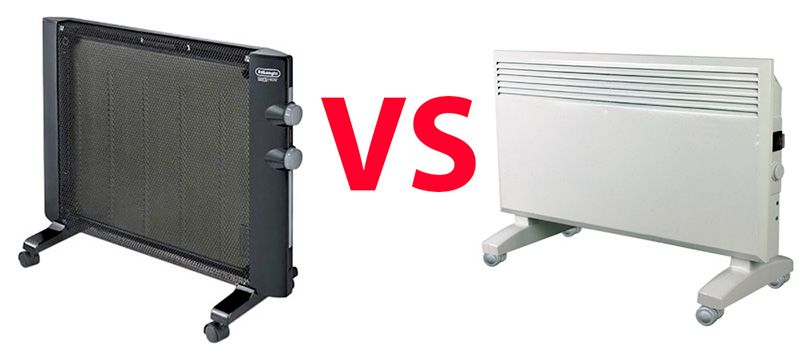What is better: convectors or radiators?
 When choosing, you should not rush, weigh the pros and cons. Carry out calculations about what is better, more efficient, more economical. Much depends on various factors, the area and volume of the room, is it an apartment or your own house, do you need the device as an addition to an already installed heater or as the main one.
When choosing, you should not rush, weigh the pros and cons. Carry out calculations about what is better, more efficient, more economical. Much depends on various factors, the area and volume of the room, is it an apartment or your own house, do you need the device as an addition to an already installed heater or as the main one.
The content of the article
Pros and cons of radiators
The main function of a radiator is to heat the room. Not only the comfort in your apartment, but above all your health and, naturally, your budget depends on how well he copes with this. If the radiator does not heat well, you will spend money on additional heating methods and on medications. Therefore, this is an important thing during the heating season. Like any device, a radiator has its pros and cons.
Design differences
By design they are divided into 3 types:
- Panel
- Sectional
- Tubular.
Below we will consider these types and their pros and cons.
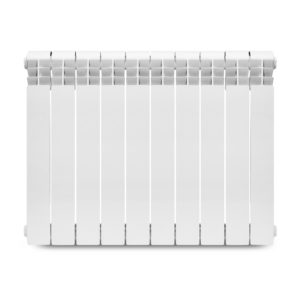 Panel devices consist of rectangular panels with vertical channels through which some kind of coolant flows (in most cases it is water). It has a beautiful appearance and is suitable for any interior. But there is a significant disadvantage - they create low working pressure. Therefore, in order for the coolant to circulate, additional pumps are needed. And this increases the cost of heating.Therefore, they are practically not used in the private sector.
Panel devices consist of rectangular panels with vertical channels through which some kind of coolant flows (in most cases it is water). It has a beautiful appearance and is suitable for any interior. But there is a significant disadvantage - they create low working pressure. Therefore, in order for the coolant to circulate, additional pumps are needed. And this increases the cost of heating.Therefore, they are practically not used in the private sector.
Tubular radiators consist of bent steel pipes connected at the top and bottom by manifolds. This is the most expensive type of battery to operate.
The material used for sectional devices is cast iron, aluminum or steel. The radiator itself is assembled from sections, the number of which depends on the size of the room, its purpose (residential, office, warehouse), the need for heating intensity, etc. The most striking example of sectional radiators is the classic cast-iron radiators, which are familiar to any Soviet resident.
Differences between radiators by material of manufacture
Cast iron. This type of battery is still widespread, especially in apartment buildings built during the Soviet period. They are still produced today, albeit with an improved design.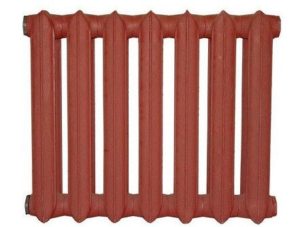
Pros:
- suitable for any coolant;
- not capricious about the composition of the water, maybe dirty, hard, with fuel oil, with other impurities;
- if you use hard water in batteries, then, despite the contamination received over the years of operation, their heat transfer does not change;
- have the ability to retain heat for a long time;
- have a long service life, more than 40 years;
- able to withstand temperatures up to 1300WITH;
- if necessary, the number of sections can be changed, either reduced or increased, without any problems.
Minuses:
- have significant weight (one section 5-7 kg);
- it takes a lot of time to heat up the sections;
- have a small heat transfer area;
- unattractive design for today;
- They are difficult to clean, it is difficult to remove dust, dirt, etc. from them.
Aluminum. There are two types: European (standard) and reinforced. They differ in operating pressure, 6 and 12 atmospheres, respectively.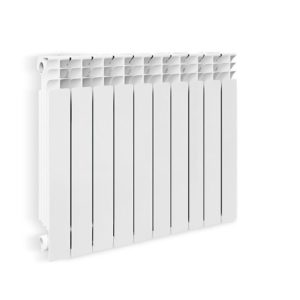
Pros:
- have high heat transfer;
- able to withstand high pressure levels;
- to increase the heat transfer area, additional plates are mounted to the main part of the radiator;
- compared to cast iron, they are light in weight and aesthetically pleasing;
- easy to install.
Minuses:
- the acidity of the coolant should not be high (Ph < 7.5);
- when used with other materials, for example, when attached to a riser made of another material, they are subject to corrosion;
- An automatic air vent is required, otherwise the sections will begin to collapse.
Steel. Most often used in the private sector, in individually built houses. They consist of radiators with plates that create channels for coolant circulation.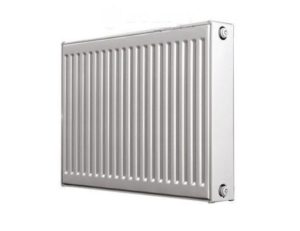
Pros:
- are light in weight;
- have good heat dissipation;
- heat up in a short time;
- easy to install;
- inexpensive.
Minuses:
- not designed for high pressure (therefore not suitable for multi-storey buildings);
- not resistant to corrosion;
- a constant presence of water is required.
Bimetallic. The design is based on an aluminum body with a steel pipe. The advantage of this type of radiator is that water does not come into contact with aluminum, as in aluminum radiators, but circulates through a steel pipe and transfers heat from it to aluminum panels.
Pros:
- Able to withstand high pressures - 20-30 atmospheres;
- The acidity of the coolant is not important;
- They have high heat transfer;
- They have a modern design and are able to heat large areas;
Minuses:
- the most expensive of all types of batteries;
- installation requires a specialist; if installed incorrectly, they can overheat and be destroyed;
- An automatic air outlet is required.
Tubular radiators made of steel.The design is based on 2 collectors connected by spot welding with steel tubes. A small volume of coolant is required for heating. They are located both vertically and horizontally, thereby suiting any design of any interior.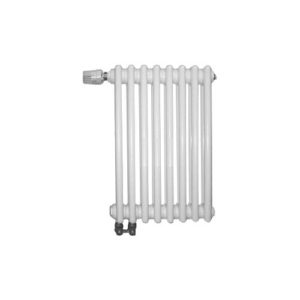
Pros:
- able to quickly change heating temperatures;
- They do not have a single standard and are distinguished by a wide variety of shapes and sizes.
Minuses:
- subject to corrosion;
- are expensive.
Having considered the pros and cons of radiators, we begin to choose the most suitable one.
Important! When choosing a device, you should pay attention to several things, not only its cost and aesthetic qualities, but also its reliability and durability in operation. We remember that the main function of a radiator is to make our home warm. Everything else, aesthetics, material, price, is secondary.
Before choosing, you must decide what area needs to be heated and what the average temperature should be there. We also pay attention to the quality of the water; if the acidity index of your water exceeds 7.5, then you should not buy aluminum batteries. If you have a small home, one type of radiator will do, if you have a large home, another type will do. Therefore, we begin any choice with the question: “For what purposes is it needed?” Heat 20 squares or 150. Depending on this, we will choose the best option. Our main goal when choosing is to save money.
Important! There is no point in buying a radiator designed for 100 meters for a room of 30 square meters and vice versa.
Advantages and disadvantages of convectors
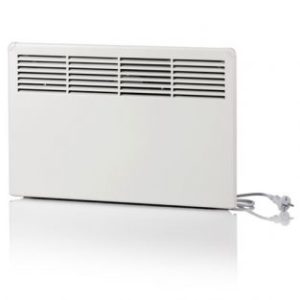 Convectors are devices in which a heating element warms the warm air in the apartment by creating natural air circulation (convection), rather than radiation, like radiators.
Convectors are devices in which a heating element warms the warm air in the apartment by creating natural air circulation (convection), rather than radiation, like radiators.
Mainly consist of:
- made of a rectangular metal body;
- from an element that is responsible for heating and is mounted in the lower part of the device;
- thermostat.
The principle of operation of the convector is that unheated air, entering the lower part, passes through the heating device and, having heated up, leaves the device through the upper part. Due to the directed movement of warm air, the room heats up quickly and evenly.
There are:
- electrical;
- water;
- gas.
They are safe to use and do not require significant maintenance; just plug them in, set the required data and the device will start working.
Advantages of convectors:
- quickly heat the room; it has been established that the radiator heats the room twice as fast;
- equipped with a heat regulator; when the desired temperature level is reached, they turn off and turn on only when the temperature drops;
- fireproof, say, in contrast to an oil radiator, in which oil can catch fire;
- protected from overheating.
They also have a number of other advantages, such as compactness, ease of installation, compliance with modern design rules, etc.
They have disadvantages:
- consume a lot of electricity;
- can create drafts in the room;
- dry the air;
- accumulate dust.
When choosing a convector, you should take into account other factors, but first of all, your desires and financial capabilities.
What is better to buy a convector or radiator for an apartment?
Having considered the pros and cons of radiators and convectors, let’s begin to compare them. It should be immediately noted that the development of technology is rapidly moving forward, most of the shortcomings are being eliminated, and today it is difficult to detect a significant difference between radiators and convectors.But let's try to find the main differences.
Compactness. Convectors win in this category. They are more compact than radiators and take up less space, especially when compared with older models.
Heating the room. Convectors cope with this task much faster. But at the end of the work, the convector immediately stops heating the room, while the radiator still gives off heat.
Safety. Since a convector heats its body to lower temperatures than a radiator, it is generally accepted that a convector is safer. You can get burned from an overheated radiator surface, but this is impossible from a convector.
Heating large rooms. Here, of course, the convector gives way to a radiator. Radiators are capable of heating large rooms. While a convector cannot do this.
In terms of ease of maintenance, radiators are simpler. All you have to do is wipe off the dust, rinse and that’s it. Convectors must be cleaned and disassembled. Since with air circulation a lot of dust with various small particles gets inside.
Price. At the moment it is difficult to find a definite answer. Recently, so many models have been invented and designed that deviations can be found in both one and the other direction.
These and other questions will guide your choice. Before doing this, it is also recommended to consult with a specialist.




